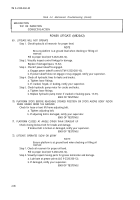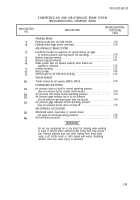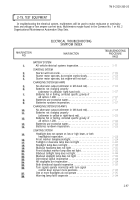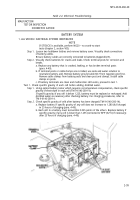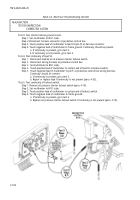TM-9-2320-260-20 - Page 183 of 1337
TM 9-2320-260-20
Section VI. ELECTRICAL SYSTEMS TROUBLESHOOTING
I
2-14. GENERAL
a.
This section provides information to diagnose and correct malfunctions of the electrical systems.
Because of its complexity, the electrical system is divided into the following functional systems:
Battery System (page 2-99)
●
Starting System (page 2-102)
●
Charging System (60 amp) (page 2-113)
●
Charging System (100 amp) (page 2-118)
●
Lighting System (page 2-124)
• Indicators, Gages, and Warning System (page 2-152)
●
Heating System (page 2-167)
Brake System (M816, M819, M821) (page 2-178)
●
Auxiliary Power Systems (page 2-181)
• Trailer Connection System (page 2-184)
b.
The wiring schematic (Appendix E of this manual) shows the interrelationship of these systems and
should be used as a reference when performing electrical troubleshooting (table 2-4).
c.
Use Fuel and Electrical Repair Kit, SC 5180-95-CL-B08, when replacing or repairing electrical wires
and connectors.
d.
Each malfunction symptom given for an individual component or system is followed by a step(s) that
should be taken to determine cause and corrective action that must be taken to remedy the problem.
e. Before taking any action to correct a possible malfunction, the following rules should be followed:
(1) Question operator to obtain information that might help determine the cause of the problem.
(2) Never overlook the chance that the problem could be of simple origin. The problem could be
corrected with minor adjustment.
(3) Use all senses to observe and locate troubles.
(4) Use all recommended test instruments or gages to help determine and isolate the problem.
(5) Always isolate the system where the malfunction occurs and then locate the defective component.
(6) Use standard automotive theories and principles when troubleshooting the vehicles covered in this
manual.
f.
Table 2-4 lists electrical malfunctions that may occur in individual systems of the vehicle. This table
covers electrical troubleshooting only. Troubleshooting procedures for the mechanical systems can be found
in table 2-2, section IV.
g.
The following warnings apply to all malfunctions listed in electrical troubleshooting (table 2-4) and
shall be adhered to:
●
●
●
●
●
●
WARNING
Battery acid (electrolyte) is extremely harmful. Always wear safety goggles and rubber gloves, and
do not smoke when performing battery maintenance. Severe injury will result if acid contacts eyes
or skin.
Remove all jewelry such as rings, dog tags, bracelets, etc. If jewelry or disconnected battery ground
cable contact battery terminal, a direct short can result, causing instant heating of tools, severe
injury to personnel, or damage to equipment.
When removing battery cables, disconnect ground cable first. Do not allow tools to come in contact
with vehicle when disconnecting cable clamps. A direct short can result, causing instant heating of
tools, injury to personnel, tool damage, battery damage, or battery explosion.
Some vehicles have two separate wires and connectors. Mark wires for installation. Connecting wires
on wrong terminals may cause fuel to ignite, resulting in injury to personnel.
Do not perform battery system checks or inspection near open flame. Injury to personnel may result.
Do not perform testing near fuel tank with fill cap or sending tank removed. Fuel may ignite, causing
injury to personnel.
2-96
Back to Top

